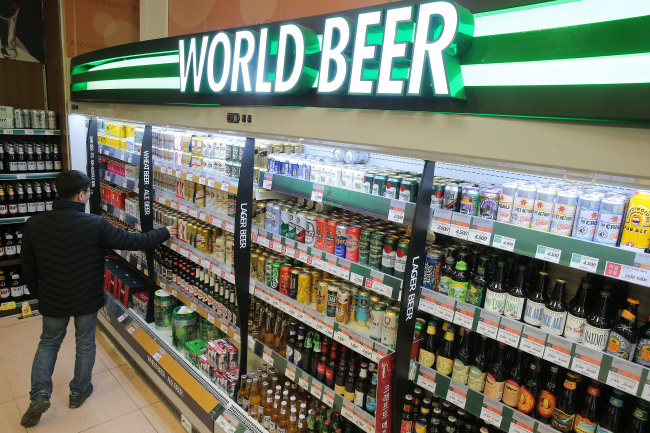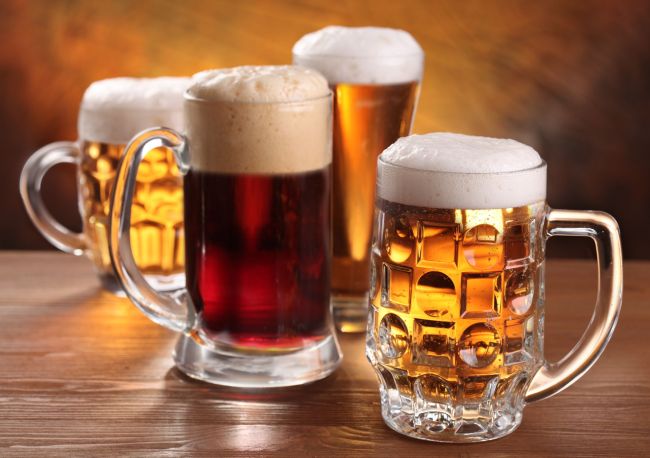Beer emerging as Korea’s top-selling alcohol
Beer imports more than triple in five years, says Food Ministry
By 손지영Published : Jan. 7, 2016 - 17:55
Beer has emerged as South Korea’s most popular liquor by sales, preference and market share, edging out soju, long considered a “national drink,” as consumer tastes lean toward low-alcoholic drinks.
Korea’s total beer shipment surged 5.1 percent from 1.96 million kiloliters in 2009 to reach some 2.06 million kiloliters in 2013, according to a 2015 report recently released by the Ministry of Agriculture, Food and Rural Affairs.
During the same period, shipments of soju — around three to four times as strong in alcohol content as conventional beers — declined by 2.5 percent from 929,000 to 905,000 kiloliters.

“As Koreans become more health-conscious and a culture discouraging binge drinking expands, light, ready-to-drink liquors and imported beers are enjoying heightened popularity while consumption of strong liquors is declining,” the ministry said.
Reflecting shifting consumer tastes, beer accounted for 52.3 percent while soju took just 28.1 percent of the country’s total beer retail market in 2014, valued at around 5.3 trillion won.
Of 500 Koreans surveyed by the ministry, 48.8 percent, said they preferred to drink beer over other liquors, though by gender, males still chose soju (46.4 percent) over beer (44.8 percent), according to the report.
Driving the popularity of beer in Korea is not only a general preference for liquor with lower alcohol content but also the sheer diversity of beers that have become locally available in recent years.
Leading the so-called beer boom in Korea is the emergence of imported beers from around the world, particularly those from Europe, available in various flavors, aromas and types, shaking up the local beer industry long monopolized by domestic brewers.
The value of Korea’s total beer imports more than tripled from $37.16 million (41,492 tons) in 2009 to $116.9 million (119,501 tons) in 2014, according to the Food Ministry.
Ranging from various lagers — under which conventional Korean beers are categorized — to stouts, porters, malts and lighter ales, imported beers produced under differing fermentation techniques for unique tastes offer local drinkers wider selections.

The sharp increase in beer imports is closely linked to “Korea’s free trade agreement with Europe, which has eased the inflow of European beers that have shifted consumer tastes toward more diverse beer tastes,” the ministry said.
In other words, Korea’s free trade pacts have significantly lowered the entrance barrier for foreign liquor companies to enter Korea, compared to in the past.
At local supermarkets and convenience stores today, hundreds of imported beer brands await customers. Though prices vary, foreign beers have become available at affordable prices, thanks to various discounts available for purchases made in bundles as well as frequent promotional events.
“Compared to years ago, I can easily access and purchase a variety of beers from around the world just about any brewery and supermarket these days. It’s great,” said Kim Sung-hyun, a 30-year-old office worker living in southwestern Seoul.
“For similar or even slightly higher prices, I would choose to drink foreign beers over Korean beers any time, because they simply taste better than local beers,” said Kim.
As foreign beers surge in popularity, local beer makers have raised concerns that “foreign beer imports unfairly benefit from structural benefits including differing tax systems.”
Right now, domestic liquors, including beer, are subject to a 72 percent tax on their final wholesale price, which includes all production costs and expected profit margins.
On the other hand, foreign beers are subject to a 72 percent tax on their reported wholesale price that includes a 15 percent tariff. Final consumer prices and sales margins are subsequently determined by the importer.
At the same time, critics point out that rather than strengthening price regulations on foreign beers, Korean beer producers must work on improving quality and taste of local beers.
“Korean beer-makers will need to work to diversify their products make efforts to enhance and develop more original tastes to remain competitive against foreign beer brands,” said an industry official.
By Sohn Ji-young (jys@heraldcorp.com)




![[Herald Interview] 'Amid aging population, Korea to invite more young professionals from overseas'](http://res.heraldm.com/phpwas/restmb_idxmake.php?idx=644&simg=/content/image/2024/04/24/20240424050844_0.jpg&u=20240424200058)












![[KH Explains] Korean shipbuilding stocks rally: Real growth or bubble?](http://res.heraldm.com/phpwas/restmb_idxmake.php?idx=652&simg=/content/image/2024/04/25/20240425050656_0.jpg&u=)

